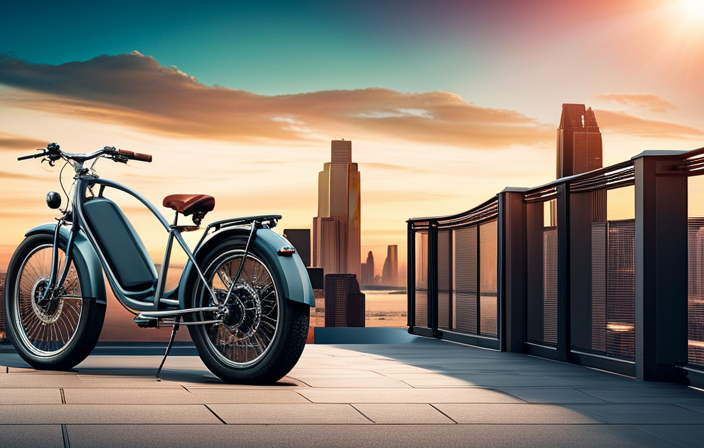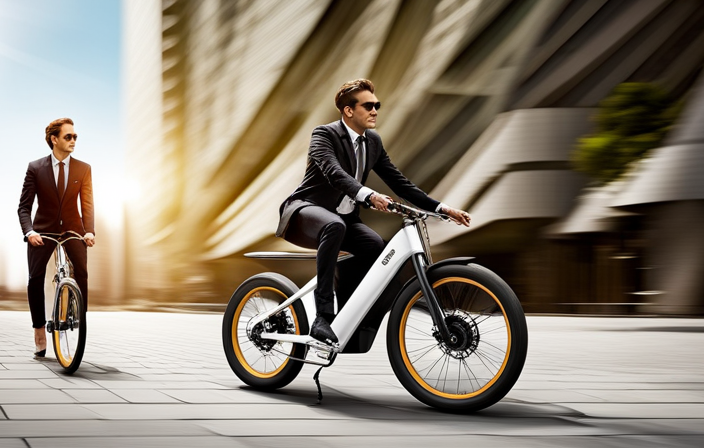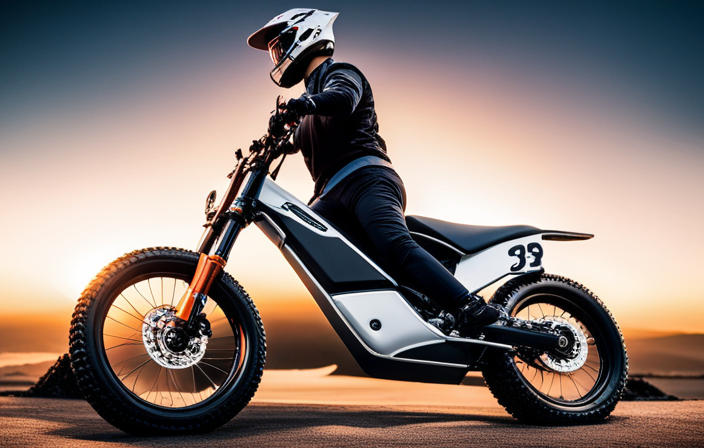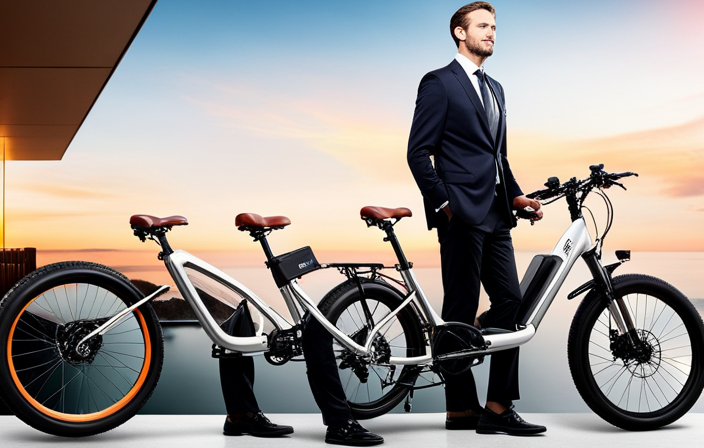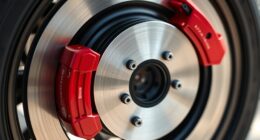Did you know that electric bikes are becoming increasingly popular, with sales doubling in the past year alone? If you’re one of the many people who have joined the e-bike revolution, you may be wondering how to keep your bike charged and ready for your next adventure.
In this article, I will guide you through the process of charging your electric bike, from understanding the battery type and capacity to troubleshooting common issues.
So let’s dive in and discover how to keep your e-bike juiced up and ready to go!
Key Takeaways
- Use the correct charger to avoid damage.
- Avoid charging unattended to prevent accidents or theft.
- Keep the battery between 20% and 80% charged to maximize battery life.
- Plan ahead and have a fully charged battery before traveling, and research charging stations along your route.
Understanding the Battery Type and Capacity
If you want to make sure your electric bike has enough power to go the distance, it’s important to understand the type of battery and its capacity. Battery maintenance is key to ensuring your electric bike performs optimally. Different electric bikes come with different types of batteries, such as lithium-ion or nickel-metal hydride, each with their own advantages and disadvantages. It’s important to know which type your bike has and how to properly care for it.
Additionally, the battery capacity determines how far your bike can travel on a single charge. Charging efficiency is another factor to consider. Some batteries may take longer to charge than others, so it’s important to plan your charging routine accordingly.
Now that you understand battery types and capacity, let’s move on to locating the charging port on your electric bike.
Locating the Charging Port on Your Electric Bike
To juice up your e-bike, simply locate the charging port, plug it in, and watch the power flow in like a lightning bolt. Charging your electric bike is a breeze when you know where to find the charging port.
Most e-bikes have the charging port conveniently located on the frame or near the battery. Once you’ve located the charging port, follow these steps:
- Ensure your bike is turned off before connecting the charger to the charging port.
- Insert the charger plug into the charging port firmly.
- Connect the charger to a power source, such as a wall socket.
Taking care of your battery and using the right charging accessories is crucial for maintaining its longevity. Make sure to use the charger specifically designed for your e-bike model and avoid using third-party chargers.
Now that you know how to locate the charging port, let’s move on to gathering the necessary charging equipment.
Gathering the Necessary Charging Equipment
When it’s time to power up your e-bike, it’s essential to have all the necessary charging equipment on hand.
To ensure battery care and maximize charging efficiency, there are a few key items you’ll need. First and foremost is the charger specifically designed for your electric bike model. Using a different charger can damage the battery or reduce its lifespan.
Additionally, having a surge protector is a wise investment to protect your charger and e-bike from power fluctuations. Another useful tool is a charging timer, which allows you to set a specific charging duration to prevent overcharging.
Finally, it’s recommended to have a clean, well-ventilated space for charging. This helps maintain the battery’s temperature and ensures safety.
Once you have gathered all the necessary charging equipment, it’s time to move on to the next step: plugging the charger into a power source.
Plugging the Charger into a Power Source
Now that you have all the necessary charging equipment, it’s time to find a nearby power source and plug in your charger.
It is important to ensure that the power source you choose is compatible with your electric bike’s battery. Most electric bike chargers are designed to work with a standard household outlet, but some may require a higher voltage outlet. Check the specifications of your charger and ensure that the power source can provide the required voltage.
Once you have identified a suitable power source, simply plug the charger into the outlet. The charger should have a cord with a plug on one end and a connector on the other end. Insert the plug into the outlet and make sure it is securely connected.
Next, you will need to connect the charger to your electric bike to start charging the battery. [Transition sentence into the subsequent section about connecting the charger to your electric bike.]
Connecting the Charger to Your Electric Bike
Once you’ve found your power source, it’s time to connect the charger to your electric bike and get that battery charging! To ensure a successful and efficient charging process, it’s important to understand the charging voltage of your electric bike. Most electric bikes operate on a voltage range of 36V to 48V, so it’s crucial to use a charger that matches this voltage to avoid damaging the battery.
To connect the charger, locate the charging port on your electric bike. It is usually located near the battery and is marked with a charging symbol. Align the charger plug with the charging port and firmly push it in until it clicks into place. Once connected, you’ll notice a light indicator on the charger that signals the charging process has begun.
Optimizing charging efficiency is also important. Avoid overcharging your battery by disconnecting the charger once it reaches full capacity. This ensures a longer battery lifespan.
Transitioning into the next section about monitoring the charging progress, it’s essential to keep an eye on the charging status to prevent any issues and ensure a successful and timely charging process.
Monitoring the Charging Progress
To make sure your battery is charging effectively, it’s crucial to keep an eye on the progress and make any necessary adjustments. Battery monitoring is essential for maintaining the longevity and charging efficiency of your electric bike.
Most electric bikes come with a built-in battery management system that allows you to monitor the charging progress. This system usually displays important information such as the current battery level, charging voltage, and charging time. By regularly checking this information, you can ensure that your battery is charging at the optimal rate and avoid overcharging or undercharging.
Monitoring the charging progress also allows you to estimate the remaining charging time and plan accordingly. With proper battery monitoring, you can maximize the performance and lifespan of your electric bike’s battery.
Speaking of charging time and duration…
Charging Time and Duration
Keep an eye on the clock to ensure you’re not waiting too long for your battery to fully charge. The charging time and duration of an electric bike can vary depending on various factors such as the battery capacity, charging speed, and optimal charging methods.
Typically, it takes around 4 to 6 hours to fully charge an electric bike battery. However, some newer models with advanced charging technology can charge the battery in as little as 2 to 3 hours.
To optimize the charging speed, it is recommended to use the charger provided by the manufacturer and avoid using third-party chargers. It’s also important to ensure that the charging port is securely connected and that the battery is not exposed to extreme temperatures.
Following these best practices for charging your electric bike will help maintain the battery’s longevity and ensure you’re back on the road in no time.
Best Practices for Charging Your Electric Bike
Make sure you follow these best practices when juicing up your e-bike to keep it running smoothly and extend its battery life.
Proper battery maintenance is crucial for maximizing the performance and lifespan of your electric bike. To maintain optimal charging efficiency, it is recommended to charge your battery after each ride, regardless of the remaining charge level. Avoid letting the battery drain completely, as this can lead to decreased battery capacity over time.
Additionally, it is important to use the charger provided by the manufacturer and avoid using third-party chargers, as they may not be compatible or may not provide the necessary voltage and current.
Lastly, make sure to store your e-bike in a cool and dry place when not in use to prevent any damage to the battery. By following these guidelines, you can ensure that your e-bike stays in peak condition.
Now, let’s move on to some charging safety tips.
Charging Safety Tips
Ensuring the safety of your e-bike’s charging process is of utmost importance to protect both yourself and your investment. Here are some charging safety tips to keep in mind:
| Safety Tip | Description | Explanation |
|---|---|---|
| 1. | Use the right charger | Using the charger that came with your electric bike is crucial for battery maintenance and avoiding potential damage. |
| 2. | Avoid charging unattended | Always keep an eye on your e-bike while charging to prevent any accidents or theft. |
| 3. | Check charging station availability | Before embarking on a long ride, verify the availability of charging stations on your route to avoid running out of battery power. |
By following these safety tips, you can ensure a smooth and secure charging process for your electric bike. Next, we will discuss maximizing battery life and getting the most out of your e-bike’s power source.
Maximizing Battery Life
Now that we’ve covered some important safety tips for charging your electric bike, let’s talk about maximizing battery life.
Extending the lifespan of your battery is crucial for preventing battery degradation and ensuring that your electric bike continues to perform at its best. One way to do this is by avoiding extreme temperatures, as both extreme heat and cold can negatively impact battery performance.
It’s also important to avoid fully draining the battery and instead, aim to keep it between 20% and 80% charged. Regularly charging your battery, even for short periods, can help maintain its overall health. Additionally, storing your electric bike with a partially charged battery can help prevent long-term capacity loss.
By taking these measures, you can ensure that your battery remains in top condition and your electric bike continues to provide reliable performance.
Now, let’s move on to the next section and discuss charging options when traveling.
Charging Options When Traveling
While on the go, it’s convenient to have various options for recharging your e-bike battery. When traveling, it’s important to plan ahead and ensure that you have a fully charged battery before hitting the road. This will give you peace of mind knowing that you have enough power to get to your destination.
Additionally, it’s always a good idea to research and find charging stations along your route. Many cities now have dedicated charging stations specifically for electric bikes, making it easier than ever to top up your battery while on the move. Some apps and websites can help you locate these stations.
By traveling with a charged battery and knowing where to find charging stations, you can enjoy longer rides without worrying about running out of power.
Now, let’s talk about charging etiquette in public spaces.
Charging Etiquette in Public Spaces
In crowded public spaces, it’s important to be considerate of others when recharging your e-bike battery. Charging in shared spaces requires following proper charging etiquette to ensure a harmonious environment for all. Here are a few guidelines to keep in mind:
| Etiquette Tips | Explanation |
|---|---|
| 1. Be mindful of time | Limit your charging time to allow others to access the charging station. |
| 2. Don’t hog the outlet | If multiple outlets are available, use only one and leave the others free for others to use. |
| 3. Keep the area clean | Dispose of any trash properly and leave the charging station area tidy for the next user. |
By adhering to these guidelines, we can create a positive charging experience for everyone. Now, let’s move on to troubleshooting common charging issues to ensure a smooth e-bike charging process.
Troubleshooting Common Charging Issues
If you’re experiencing any problems with your e-bike battery charging, don’t worry, there are solutions to common issues that can help ensure a smooth and efficient charging process.
One common issue is a battery that won’t charge at all. Before troubleshooting, make sure the charger is properly connected to the battery and the power source. If that’s not the problem, check for any loose connections or damaged wires.
Another issue is overcharging, which can reduce the battery’s lifespan. To prevent overcharging, it’s important to use the correct charger specified for your e-bike model and avoid leaving the battery plugged in for an extended period of time. It’s also a good idea to periodically check the battery’s charge level during charging.
By taking these steps, you can troubleshoot common battery issues and ensure a reliable charging process.
Moving on to maintaining and cleaning your charging equipment…
Maintaining and Cleaning Your Charging Equipment
Taking care of your charging equipment is essential for ensuring the longevity and efficiency of your e-bike battery. To properly maintain your charging equipment, start by regularly inspecting the charging cable for any signs of damage or wear. If you notice any issues, it’s important to replace the cable to prevent any potential safety hazards.
Additionally, make sure to clean the charging connectors and ports on both the charger and the e-bike regularly to remove any dirt or debris that may affect the charging process. When it comes to battery maintenance, it’s important to follow the manufacturer’s guidelines for proper storage, such as avoiding extreme temperatures and keeping the battery at a partial charge when not in use.
By properly maintaining and cleaning your charging equipment, you can ensure a longer lifespan for your e-bike battery.
Now, let’s move on to frequently asked questions about charging electric bikes.
Frequently Asked Questions about Charging Electric Bikes
Now that we’ve covered the importance of maintaining and cleaning your charging equipment, let’s dive into some frequently asked questions about charging electric bikes.
As an avid electric bike rider, I understand the need for efficient charging and maximizing battery lifespan. When it comes to charging efficiency, it’s important to use a charger specifically designed for your electric bike model. This ensures that the charging process is optimized and you get the most out of each charge.
Additionally, it’s crucial to avoid overcharging your electric bike’s battery, as this can significantly reduce its lifespan. To prolong battery life, it’s recommended to charge your electric bike regularly, even if you haven’t completely drained the battery. This helps maintain a healthy charge cycle and ensures optimal performance on your rides.
Frequently Asked Questions
How often should I charge my electric bike’s battery?
To extend the lifespan of an electric bike’s battery, it’s recommended to charge it regularly, ideally after each ride. Factors like battery capacity, usage frequency, terrain, and temperature can affect the charging time of the battery.
Can I charge my electric bike’s battery using a power bank?
Yes, you can charge your electric bike’s battery using a power bank. It’s a convenient and portable charging option for when you’re on the go. It’s one of the alternative charging methods available for electric bikes.
Is it safe to leave my electric bike’s battery charging overnight?
Charging an electric bike’s battery overnight can negatively impact battery longevity. It is important to follow safety precautions such as using the correct charger, avoiding overcharging, and keeping the battery away from flammable materials.
How long does it take for an electric bike’s battery to fully charge?
The time it takes for an electric bike’s battery to fully charge depends on several factors, such as battery capacity and charger output. To maximize the lifespan of the battery, it’s important to avoid overcharging and extreme temperatures.
Can I use a different charger to charge my electric bike’s battery?
Yes, it is possible to use a different charger to charge your electric bike’s battery. However, it is important to ensure that the charger is compatible with your bike’s battery. Charging times may vary depending on the charger used.
Conclusion
In conclusion, charging an electric bike is a simple and straightforward process that anyone can do. By understanding the battery type and capacity, locating the charging port, and gathering the necessary equipment, you can easily keep your electric bike charged and ready for your next adventure.
Just like filling up a gas tank, charging an electric bike is a necessary step to keep it running smoothly. So, next time you plug in your bike, imagine it as giving it a refreshing drink of energy, rejuvenating its power for the road ahead.
